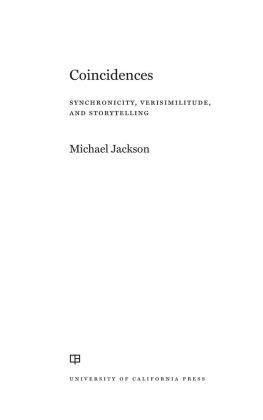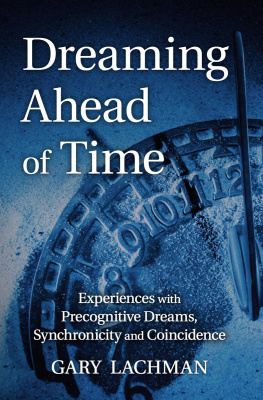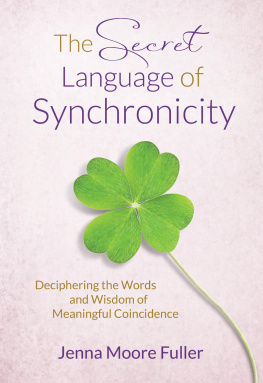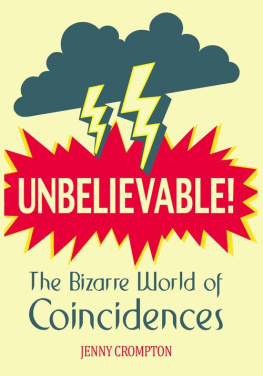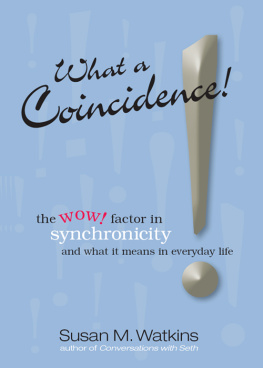The publisher and the University of California Press Foundation gratefully acknowledge the generous support of the Simpson Imprint in Humanities.
University of California Press
Oakland, California
2021 by Michael Jackson
Library of Congress Cataloging-in-Publication Data
Names: Jackson, Michael, 1940 author.
Title: Coincidences : synchronicity, verisimilitude, and storytelling / Michael Jackson.
Identifiers: LCCN 2020046911 (print) | LCCN 2020046912 (ebook) | ISBN 9780520379954 (cloth) | ISBN 9780520379961 (paperback) | ISBN 9780520977013 (epub)
Subjects: LCSH : Coincidence.
Classification: LCC BF1175 .J44 2021 (print) | LCC BF1175 (ebook) | DDC 133.8dc23
LC record available at https://lccn.loc.gov/2020046911
LC ebook record available at https://lccn.loc.gov/2020046912
Manufactured in the United States of America
29 28 27 26 25 24 23 22 21
10987654321
Preface
Our lives are, for the most part, made up of unremarkable events. Inevitably, however, the course of every life is punctuated by events that disturb and astonish in equal measure, and when we recount our lives as stories we often single out such events as turning points or moments of truth. This book is about such events. Its particular focus is on coincidences, the remarkable concurrences of events or circumstances that have no discernible causal connection, and the notions of luck, fate, and providence to which these events give rise. Whether coincidences are construed as fortunate or unfortunate, tragic or transformative, they always evoke wonder and, as the saying goes, make us think.
As I am writing, my faculty assistant, Andrea Davies, appears in the doorway of my office, and we fall into conversation. At one point, Andrea mentions that she wrote her MFA thesis on James Baldwins nonfiction and his use of coincidence. When I mention that I happen to be writing a book about coincidence and ask Andrea which of Baldwins works I might refer to, she suggests I read the opening lines of Notes of a Native Son .
On the 29th of July, in 1943, my father died. On the same day, a few hours later, his last child was born. Over a month before this, while all our energies were concentrated in waiting for these events, there had been, in Detroit, one of the bloodiest race riots of the century. A few hours after my fathers funeral, while he lay in state in the undertakers chapel, a race riot broke out in Harlem. In the morning of the 3rd of August, we drove my father to the graveyard through a wilderness of smashed plate glass.
As we drove him to the graveyard, the spoils of injustice, anarchy, discontent, and hatred were all around us. It seemed to me that God himself had devised, to mark my fathers end, the most sustained and brutally dissonant of codas. And it seemed to me, too, that the violence which rose all about us as my father left the world had been devised as a corrective for the pride of his eldest son.
This coincidence of a personal tragedy and a social calamity prompted Baldwin, the eldest son, to ponder the connection between his fathers generation and his own as well as the connection between the race riots in America and the biblical apocalypse.
Coincidences typically occasion quite different interpretations, and my ethnographic research in Aboriginal Australia and West Africa has taught me that while Western intellectuals tend to refer coincidences to that landscape of shadow that has been termed, directly or indirectly, the unconscious, preliterate peoples tend to invoke unknown forces like witchcraft and sorcery, lying at the periphery of their social fields. As Michel Foucault observes, the unthought may be construed as deep within like a shrivelled-up nature or a stratified history or as something exterior to us, in the penumbra as it were, an Other that is not only a brother but a twin, born, not of man, nor in man, but beside him and at the same time, in an identical newness, in an unavoidable duality. it is practically impossible to sustain any hard and fast distinction between a mode of thought that focuses on the unconscious mind and a mode of thought that focuses on the dilemmas and difficulties of social relations. As Baldwins compelling account of the coincidence of his fathers death and the 1943 Detroit race riots indicates, theological, sociological, and psychological interpretations may all be inspired by the same event. Aboriginal people speak of the Dreaming as an ancestral yet timeless field of being that is occasionally and partially glimpsed by the living in their dreams. For many African people, the mysteries of the invisible can be penetrated by diviners gifted with second sight or assisted by spirit allies. In religions throughout the world, the invisible is a numinous realm to which one rarely gains direct access, though it can be reached by means of prayer, ordeal, and ritual. For scientists, the invisible consists in hidden laws of cause and effect that rational inquiry and sophisticated instruments can bring to light. For many anthropologists, the field of intersubjective life is the subject of their concern: the social matrices in which we are embedded and the dynamic forces that govern our interactionslove and hate, reciprocity and exchange, attachment and separation, certainty and uncertainty, power and powerlessness, war and peace.
What is common to all these interpretive traditions is the mysterious relationship between the visible and invisible dimensions of human existence, the landscape of shadow that lies between the known and the unknown and is at once exterior and interior to us. not by glib reiterations of the view that facts speak for themselves but by acknowledging that our evolutionary, genealogical, historical, mythological, and biographical pasts bequeath to us a constellation of elements that emerge in different permutations and combinations at different moments in life, and that our perception of reality reflects these ever-changing assemblages that are never the same for everyone, or for any one person in any given situation. This is why one cannot entirely explain a person in terms of any one variable, be it class, culture, gender, ethnic or religious affiliation, or even personality. This is also why it is imperative to deploy a double perspective that encompasses both the object of experience and the experiencing subject, allowing that human beings are shaped by external forces and conspire in their own fates, seeing the world through the lens of their own preoccupations and interests and creating gods in their own image. One is led, therefore, to broach the philosophical problem of verisimilitude: of speaking truth-to-life, of questioning every truth claim not in order to finally arrive at the truth for once and for all but in order to more deeply appreciate the complexity of what is at play for any person, in any moment of time, or in any one place.

